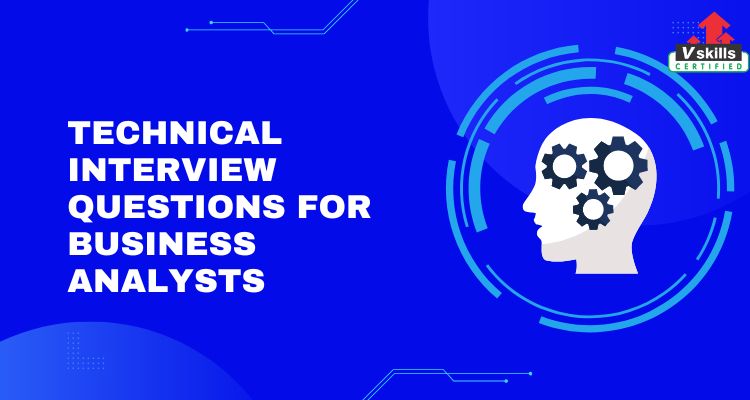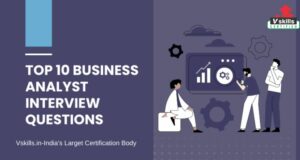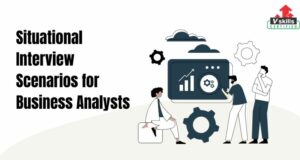Business analysts play a crucial role in bridging the gap between business needs and technical solutions. They help organizations identify opportunities for improvement, define project requirements, and ensure that technology solutions align with business goals. In today’s rapidly evolving business landscape, business analysts with strong technical skills are highly sought after.
The scope of business analysts has been gradually expanding and changing as a result of technical improvements, an increased understanding of their strategic value to organisations, and the complexity of business settings. Some of the major causes for growing importance of business analysts are digital transformation, data driven decision making, agile and lean techniques etc.As the role of a Business Analyst evolves, technical proficiency has become an integral aspect of the skill set.
Technical interviews have emerged as a critical phase in assessing the competence and skill of applicants aiming to be business analysts in the fast-paced field of business analysis. Business analysts now need to have both technical know-how and subject understanding, as businesses increasingly understand the value of data-driven decision-making. This thorough blog attempts to arm you with knowledge on the most typical technical interview questions for business analysts, assisting you in successfully navigating this essential step.
Before diving more into this topic, let us first discuss some of the key technical skills one should develop to succeed in the role of a business analyst.
Technical Skills Required by Business Analysts
1. Data Analysis and SQL: Business analysts need to extract insights from data to make informed decisions. Proficiency in SQL (Structured Query Language) allows them to query databases, retrieve relevant data, and perform basic data manipulation.
2. Data Visualization: Using tools like Tableau, Power BI, or Excel, business analysts should be able to create visually appealing and informative charts, graphs, and dashboards to communicate data-driven insights to stakeholders.
3. Requirements Elicitation and Management Tools: Familiarity with tools like Jira, Confluence, or Trello can help business analysts efficiently gather, document, and manage project requirements and related tasks.
4. Process Modelling and Workflow Tools: Understanding tools like BPMN (Business Process Model and Notation) and familiarity with process modelling software enables business analysts to map out and analyse business processes.
5. Technical Writing: Business analysts must create clear and concise documentation, including requirement documents, user manuals, and process flowcharts.
6. Basic Programming Knowledge: While not all business analysts need to be programmers, having a basic understanding of programming concepts can be beneficial. This helps them communicate effectively with development teams and understand technical limitations.
7. Agile Methodologies: Knowledge of Agile frameworks like Scrum or Kanban is essential as many organizations now use Agile practices for project management.
8. User Experience (UX) Understanding: A grasp of UX principles and design concepts helps business analysts ensure that user needs are met and that technical solutions are user-friendly.
9. Database Concepts: Understanding how databases work, including normalization and data relationships, helps business analysts when working on projects involving data storage and retrieval.
10. Version Control Systems: Familiarity with tools like Git and GitHub can be helpful, especially when collaborating with developers and managing changes to documentation.
11. Domain Knowledge: Depending on the industry, business analysts may need to have domain-specific technical knowledge. For instance, in the financial sector, knowledge of trading platforms and financial instruments could be essential.
The specific technical skills required can vary based on the industry, company, and role. Business analysts often need a combination of technical and soft skills to excel in their roles. Adaptability, problem-solving, communication, and a willingness to learn are also crucial traits for success as a business analyst.
Technical Interview Questions Categories
Technical interview questions for Business Analysts often cover a range of topics, including:
1. Data Analysis and Interpretation
– How do you approach data analysis? Describe a recent project where you analysed data to extract valuable insights.
– What are the key steps in data preprocessing, and why are they important?
– Explain the concept of data normalization and its significance in data analysis.
– How would you identify outliers in a dataset? What impact can outliers have on analysis results?
2. Statistical Concepts
– Define descriptive and inferential statistics. Provide examples of each in a business context.
– How would you choose between using mean, median, or mode to summarize data?
– Explain the Central Limit Theorem. Why is it relevant in statistical analysis?
– What is hypothesis testing? Walk us through the steps of conducting a hypothesis test.
3. SQL and Database Knowledge
– Write an SQL query to retrieve customer information from two related tables.
– What is a primary key? How does it differ from a foreign key?
– Explain the purpose of a JOIN operation in SQL. Provide an example scenario where it would be used.
– What is database normalization? Why is it important in database design?
4. Process Mapping and Modelling
– How would you create a process flow diagram for a complex business process?
– Describe the differences between Use Case diagrams and Activity diagrams. When would you use each?
– What is Business Process Modelling Notation (BPMN)? How does it aid in process modelling?
5. Tools and Software
– Are you familiar with data visualization tools? Which ones have you used, and how did they enhance your analysis?
– Have you worked with any Business Intelligence (BI) tools? Describe your experience in utilizing them.
– How do you approach learning and adapting to new software and tools in your analysis work?
6. Data Ethics and Privacy
– Discuss the importance of data privacy and ethical considerations in data analysis.
– How would you handle sensitive customer data while performing analysis?
– Explain the concept of GDPR and its implications for businesses collecting customer data.
Top 20 Technical Interview Questions for Business Analysts
Following is a list of top 20 most asked technical interview questions for business analysts –
Question 1: What is the role of a technical business analyst?
Answer: A technical business analyst bridges the gap between business requirements and technical solutions. They gather and analyse business needs, translate them into technical specifications, and collaborate with development teams to ensure the successful implementation of solutions.
Question 2: Can you explain the SDLC (Software Development Life Cycle)?
Answer: The SDLC is a process used in software development to design, develop, test, and deploy software systems. It typically includes phases like requirement analysis, design, coding, testing, deployment, and maintenance.
Question 3: How do you prioritize features in a project?
Answer: Prioritizing features involves considering factors such as business value, user impact, technical feasibility, and dependencies. A common technique is the MoSCoW method (Must have, should have, could have, Won’t have), which helps categorize and prioritize features accordingly.
Question 4: How do you gather and document requirements?
Answer: Requirements can be gathered through interviews, workshops, surveys, and studying existing documentation. They are then documented in detail using techniques like use cases, user stories, and wireframes.
Question 5: What is the importance of a Use Case Diagram?
Answer: A Use Case Diagram visually represents the interactions between users (actors) and a system. It helps in understanding the system’s functionality from a user’s perspective and identifying various use cases.
Question 6: How do you handle scope changes during a project?
Answer: Scope changes should be evaluated for their impact on the project timeline, resources, and budget. Any change should go through a formal change control process, involving stakeholders and project managers to make informed decisions.
Question 7: Can you explain the concept of ‘SMART’ goals?
Answer: SMART stands for Specific, Measurable, Achievable, Relevant, and Time-bound. It is a framework used to create well-defined and achievable project goals.
Question 8: How would you deal with conflicting requirements from different stakeholders?
Answer: Conflict resolution involves active listening, facilitating discussions, and finding compromises. It’s important to prioritize requirements based on their impact and align them with the project’s goals.
Question 9: What is a Business Process Model and Notation (BPMN) diagram?
Answer: BPMN is a graphical representation used to illustrate business processes. It provides a standardized way to visualize processes, making it easier to communicate and understand complex workflows.
Question 10: How do you ensure software quality during the development process?
Answer: Ensuring software quality involves techniques like conducting thorough testing (unit, integration, user acceptance), using code reviews, and implementing continuous integration/continuous deployment (CI/CD) pipelines.
Question 11: Explain the concept of a ‘Gap Analysis’.
Answer: Gap analysis involves comparing the current state of a system or process with the desired future state. It helps identify gaps or differences between the two states and suggests actions needed to bridge those gaps.
Question 12: What is Agile methodology, and how does it differ from Waterfall?
Answer: Agile is an iterative and collaborative approach to software development, focusing on delivering incremental value to users. Waterfall is a sequential approach with distinct phases (requirements, design, development, testing) and less flexibility for changes.
Question 13: Can you describe the process of creating a Wireframe?
Answer: A wireframe is a visual representation of the layout and functionality of a user interface. It’s created by sketching or using software tools, providing a basic outline of how elements will be arranged on a screen.
Question 14: What is Regression Testing, and why is it important?
Answer: Regression testing involves retesting a software application after changes have been made to ensure that existing functionalities still work as intended. It’s crucial to catch any unintended side effects of new changes.
Question 15: How do you handle project risks?
Answer: Managing project risks involves identifying potential risks, assessing their impact and likelihood, creating mitigation strategies, and developing contingency plans to minimize their impact on the project’s success.
Question 16: Can you explain the concept of a Data Flow Diagram (DFD)?
Answer: A Data Flow Diagram is a graphical representation that depicts how data moves through a system. It shows processes, data stores, data flows, and external entities, helping to visualize system data interactions.
Question 17: What is a Use Case, and how does it differ from a User Story?
Answer: A Use Case describes interactions between actors and a system to achieve a specific goal. A User Story is a brief description of a user’s need and the expected outcome, often written in a format like “As a [user], I want [action] so that [benefit].”
Question 18: How do you ensure that a solution meets the business requirements?
Answer: Validating a solution involves testing it against the documented requirements and conducting user acceptance testing. It’s important to involve stakeholders throughout the testing process to ensure alignment.
Question 19: Can you explain the concept of ‘Technical Debt’?
Answer: Technical debt refers to suboptimal design or code that is knowingly accepted to meet short-term deadlines. Over time, technical debt can lead to increased maintenance costs and reduced system stability.
Question 20: How do you communicate technical concepts to non-technical stakeholders?
Answer: Communication involves using simple language, visual aids like diagrams, analogies, and real-world examples to help non-technical stakeholders understand complex technical concepts.
It is important to note that these responses are intended to give you a general concept; you should tailor your comments to your experiences and the particulars of the interview.
Tips to Ace Technical Interview Questions for Business Analysts
1. Study and Practice: Thoroughly review the topics mentioned above, emphasizing areas where you feel less confident. Practice solving problems and answering questions related to each category.
2. Portfolio Review: Be ready to discuss your previous projects and how you applied technical skills to solve specific challenges. Highlight instances where your analysis led to actionable insights.
3. Behavioural Scenarios: Expect questions that assess your problem-solving skills and ability to collaborate with teams. Prepare anecdotes demonstrating your analytical thinking and adaptability.
4. Mock Interviews: Conduct mock interviews with peers or mentors to simulate the actual interview environment. Feedback from others can provide valuable insights for improvement.
5. Company Research: Familiarize yourself with the company’s industry, products, and services. Tailor your answers to showcase how your skills align with their business goals. A strong foundation in data analysis, statistics, SQL, process modelling, tools, and ethical issues is necessary for a successful technical interview. This guide has provided you with a comprehensive overview of the technical interview landscape, including various categories of questions and strategies for preparation. Keep in mind that practise and a solid conceptual grasp are the two things that lead to confidence. So, equip yourself with knowledge, practise hard, and enter your technical interview confident that you are ready to succeed and have an enormous impact as a business analyst.




